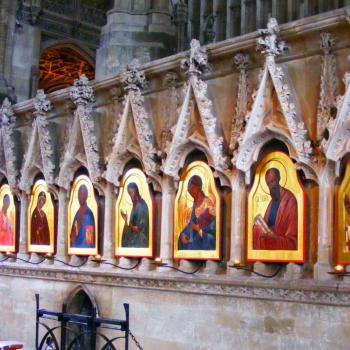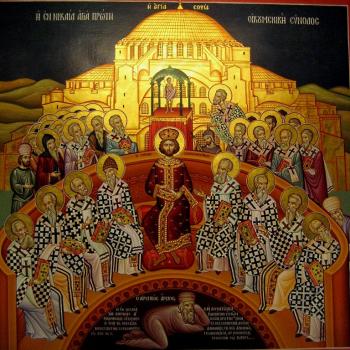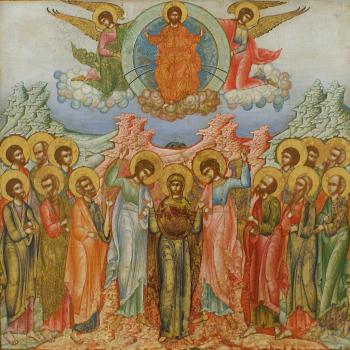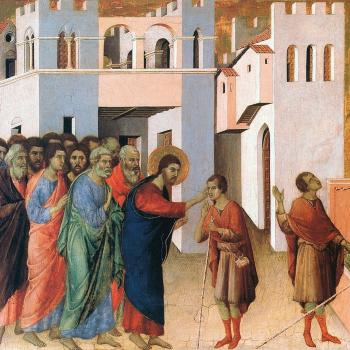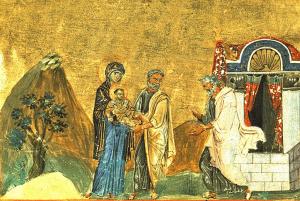
When writing an icon, only when every other element is finished, and the figure or event has been properly rendered, will an iconographer place upon it the name of the person being depicted on the icon. Writing the name on the icon is believed to be one of the most important elements in its production because it is with and through the name a connection between the saint depicted and the icon is established. This is why, even if we do not know how a particular person looked, we can make icons of them, combining particular symbolic elements with their name, to make sure that the faithful have something which they can use for their devotions.
When someone is named, that name becomes a part of them. Whenever and wherever their name is used, a part of them is being embraced. Their presence can be encountered in and through their name. Thus, even as an image of a person connects us and brings us into their presence, so we have a way to engage people through the invocation of their name. We can and will establish bonds with the saints when we use their name; our communion with them can and does come in a variety of ways, but among them, is through a personal relationship with them, a relationship which allows us to call upon them by name. Their name, no matter how arbitrary it might have been when first given to them, has a real connection and union with them for it has been assumed by them, just as when the incarnate Son of God, Jesus, in assuming human nature, not only has taken on and made humanity a part of who he is, he has taken upon himself all that is shared by humanity and embraced it, including the assumption of a name. This means we can and will find ourselves connected and united with him, indeed, in a personal relationship with him through his name. But with him, thanks to his work, especially in and through his death and resurrection, his name has been glorified, which is why it has become, as Paul said, a name above every other name: “Therefore God has highly exalted him and bestowed on him the name which is above every name, that at the name of Jesus every knee should bow, in heaven and on earth and under the earth, and every tongue confess that Jesus Christ is Lord, to the glory of God the Father” (Philip. 2:9-11 RSV).
The feast of the circumcision, and with it, the naming of Jesus, represents an important part of the incarnation. “And at the end of eight days, when he was circumcised, he was called Jesus, the name given by the angel before he was conceived in the womb” (Lk. 2:21 RSV). Christ is the express image of the living God (cf. Col. 1:15); that is, he is an icon of God, and as an icon, the process by which that image is revealed to us is finished at the time of his circumcision, for it was then when he was given the name, Jesus. His circumcision also gives us a way to better understand what it means for God the Son to be incarnate. The Logos, who otherwise by nature is unable to be contained, that is, is uncircumscribed, willingly embraces and assumes a human nature which is capable of being contained and circumscribed. We now can come in contact with him, not only in and with a visible form, but with a name which we can use to bring his presence to us. The circumcision can also be seen as a sign of the kenosis of the Son of God, not only by showing us that Jesus empties himself in a way in which he can be affected by the world around him, but also in the way the Son of God, now as a human, follows and engages not only the universal law, but the law of Moses, confirming and fulfilling its sacred purpose. And, finally, it confirms, by the fact the human body is used for a holy purpose, that the body as a whole, no matter what part is mentioned, is good, and can be used for a holy purpose. Christ’s body, including his mystical body, is important. Those who have found themselves joined to it, such as in and through baptism and confirmation (chrismation) find they are also joined to his name. This, then, explains one of the ways we can understand how Jesus’s presence is found when two or three are gathered in his name, for not only is he to be found in the invocation of his name, he is found in those who have been incorporated into his mystical body and reveal an element of that body in the community they form together. This, we find, was hinted at by St. Basil:
Then, too, the Lord has taught us the necessity of unity of action from the very construction of our bodies. For, when I reflect upon these limbs, that not one of them is sufficient in itself for activity, how shall I consider that I alone am strong enough to combat the troubles of life? In fact, neither could one foot move safely forward unless the other helped to support it, nor could the eye see clearly if it did not have the other as its partner, and if it did not, in harmony with it, cast its glance upon the objects to be seen. The hearing is more accurate when it receives the sounds through body channels; the grasp is stronger through the cooperation of the fingers. And, in general, I see that none of the actions performed either naturally or by inclination is accomplished without the agreement of kindred forces, since even prayer itself which does not come from persons praying together is much feebler, the Lord having declared that He will be in the midst if two or three call about Him with oneness of mind. [1]
In our confirmation or chrismation, we take on the name of Christ for ourselves. We are meant to represent Christ to the world, even as we are meant to represent it to the world in the community which forms the church. We find, by our connection to Christ, we are also named in and with the naming of Christ, which is how and why we can and should take on the name of Christian, showing us that, in a fashion, the incarnation is an ongoing event in world history, a event which includes us (and the whole of humanity, as everyone is called to be made one in Christ). What is contained in the circumcision and naming of Jesus are elements which we are to participate in and experience ourselves. Nonetheless, it is important to keep in mind, the reason why we can and should participate in them is because the Son of God, Jesus, embraced history, allowing himself to be circumcised and take on a name, so that those events can be shared with us. And that is what was guaranteed with his circumcision and subsequent naming, for then, he truly entered into history, not just as one of many nameless children, but as Jesus, the one who came to save the world.
[1] St. Basil the Great, Letters. Volume 1 (1-185). Trans. Agnes Clark Way (New York: Fathers of the Church, 1951), 215 [“Letter 97: To the Senate of Tyana”].
Stay in touch! Like A Little Bit of Nothing on Facebook.
If you liked what you read, please consider sharing it with your friends and family!
N.B.: While I read comments to moderate them, I rarely respond to them. If I don’t respond to your comment directly, don’t assume I am unthankful for it. I appreciate it. But I want readers to feel free to ask questions, and hopefully, dialogue with each other. I have shared what I wanted to say, though some responses will get a brief reply by me, or, if I find it interesting and something I can engage fully, as the foundation for another post. I have had many posts inspired or improved upon thanks to my readers.








